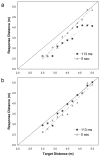From the most fleeting of glimpses: on the time course for the extraction of distance information
- PMID: 20732904
- PMCID: PMC3628738
- DOI: 10.1177/0956797610381508
From the most fleeting of glimpses: on the time course for the extraction of distance information
Abstract
An observer's visual perception of the absolute distance between his or her position and an object is based on multiple sources of information that must be extracted during scene viewing. Research has not yet discovered the viewing duration observers need to fully extract distance information, particularly in navigable real-world environments. In a visually directed walking task, participants showed a sensitive response to distance when they were given 9-ms glimpses of floor- and eye-level targets. However, sensitivity to distance decreased markedly when targets were presented at eye level and angular size was rendered uninformative. Performance after brief viewing durations was characterized by underestimation of distance, unless the brief-viewing trials were preceded by a block of extended-viewing trials. The results indicate that experience plays a role in the extraction of information during brief glimpses. Even without prior experience, the extraction of useful information is virtually immediate when the cues of angular size or angular declination are informative for the observer.
Figures




Similar articles
-
The Roles for Prior Visual Experience and Age on the Extraction of Egocentric Distance.J Gerontol B Psychol Sci Soc Sci. 2017 Jan;72(1):91-99. doi: 10.1093/geronb/gbw089. Epub 2016 Jul 29. J Gerontol B Psychol Sci Soc Sci. 2017. PMID: 27473147 Free PMC article.
-
Angular declination and the dynamic perception of egocentric distance.J Exp Psychol Hum Percept Perform. 2014 Feb;40(1):361-77. doi: 10.1037/a0034394. Epub 2013 Oct 7. J Exp Psychol Hum Percept Perform. 2014. PMID: 24099588 Free PMC article.
-
The Effects of Age and Set Size on the Fast Extraction of Egocentric Distance.Vis cogn. 2015;23(8):957-988. doi: 10.1080/13506285.2015.1132803. Epub 2016 Jan 22. Vis cogn. 2015. PMID: 27398065 Free PMC article.
-
The Mechanisms of Size Constancy.Multisens Res. 2015;28(3-4):253-83. doi: 10.1163/22134808-00002483. Multisens Res. 2015. PMID: 26288899 Review.
-
Coordinate transformations in object recognition.Psychol Bull. 2006 Nov;132(6):920-45. doi: 10.1037/0033-2909.132.6.920. Psychol Bull. 2006. PMID: 17073527 Review.
Cited by
-
Invalidly cued targets are well localized when detected.Atten Percept Psychophys. 2019 Aug;81(6):1757-1766. doi: 10.3758/s13414-019-01793-6. Atten Percept Psychophys. 2019. PMID: 31214970 Free PMC article.
-
Do Explicit Estimates of Angular Declination Become Ungrounded in the Presence of a Ground Plane?Iperception. 2018 Oct 29;9(5):2041669518808536. doi: 10.1177/2041669518808536. eCollection 2018 Sep-Oct. Iperception. 2018. PMID: 30397429 Free PMC article.
-
The Roles for Prior Visual Experience and Age on the Extraction of Egocentric Distance.J Gerontol B Psychol Sci Soc Sci. 2017 Jan;72(1):91-99. doi: 10.1093/geronb/gbw089. Epub 2016 Jul 29. J Gerontol B Psychol Sci Soc Sci. 2017. PMID: 27473147 Free PMC article.
-
Angular declination and the dynamic perception of egocentric distance.J Exp Psychol Hum Percept Perform. 2014 Feb;40(1):361-77. doi: 10.1037/a0034394. Epub 2013 Oct 7. J Exp Psychol Hum Percept Perform. 2014. PMID: 24099588 Free PMC article.
-
Temporal processing characteristics of the Ponzo illusion.Psychol Res. 2016 Mar;80(2):273-85. doi: 10.1007/s00426-015-0659-8. Epub 2015 Mar 13. Psychol Res. 2016. PMID: 25772166
References
-
- Cutting JE, Vishton PM. Perceiving layout and knowing distances: The integration, relative potency, and contextual use of different information about depth. In: Epstein W, Rogers S, editors. Handbook of perception and cognition: Vol. 5, Perception of space and motion. San Diego: Academic Press; 1995. pp. 69–117.
-
- Di Lollo V, Arnett JL, Kruk RV. Age-related changes in rate of visual information processing. Journal of Experimental Psychology: Human Perception and Performance. 1982;8:225–237. - PubMed
-
- Egeth HE, Yantis S. Visual attention: Control, representation, and time course. Annual Review of Psychology. 1997;48:269–297. - PubMed
Publication types
MeSH terms
Grants and funding
LinkOut - more resources
Full Text Sources

